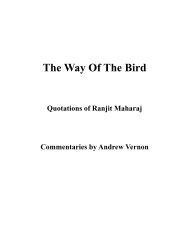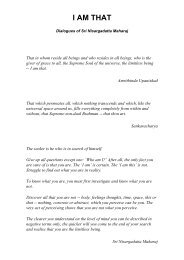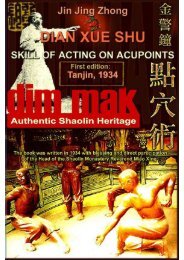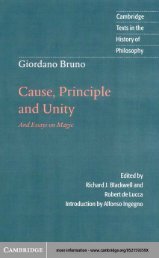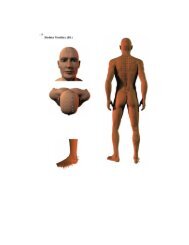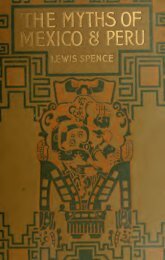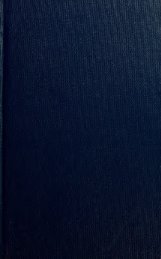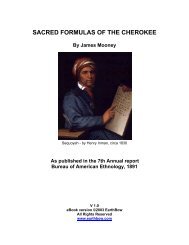Create successful ePaper yourself
Turn your PDF publications into a flip-book with our unique Google optimized e-Paper software.
It is always said that mingmen is the master of the twelve channel networks. Now, what kind<br />
of master is it exactly and what does it master? Let me put it this way: if there is no fire inside<br />
us, we cannot exist. This fire must be there first so that the twelve channel networks can be<br />
imbued with the igniting spark of transformation. mingmen, therefore, is a type of prenatal<br />
fire. This fire is immaterial and dwells in water. On earth, material fire is being quenched by<br />
water. Immaterial water, on the contrary, has the ability to generate fire. Therefore, when we<br />
say that "fire is being quenched by water" we refer to material water; when we say that "fire<br />
is being fueled by water" we refer to immaterial water. And it so happens that immaterial fire<br />
can generate immaterial water, meaning that fire is not contained within fire, but within<br />
water.<br />
Mingmen fire, is yang fire-a yang that is embedded within two yin. In the microcosmic<br />
context of the human body, mingmen is generated first, and only then the heart. Does this fact<br />
not illuminate the importance of mingmen? When the heart procures the power of mingmen,<br />
consciousness is in command, and we can relate to the outside world. When the liver<br />
procures the power of mingmen, it can plan. When the gallbladder procures the power of<br />
mingmen, it can make decisions. When the stomach procures the power of mingmen, it can<br />
absorb food. When the spleen procures the power of mingmen, it can transport. When the<br />
lung procures the power of mingmen, it can fulfill its administrating and regulating functions.<br />
When the large intestine procures the power of mingmen, it can pass on the waste. When the<br />
small intestine procures the power of mingmen, it can disseminate. When the kidney procures<br />
the power of mingmen, it can bring about physical vigor. When the triple burner procures the<br />
power of mingmen, it can keep the body's water pathways unobstructed. When the bladder<br />
procures the power of mingmen, it can store. In other words, there is not a single one among<br />
the organ networks that does not rely on the mingmen fire for warmth and nourishment.<br />
This type of fire should be tonified rather than purged. This is done by tonifying fire within<br />
water, and especially by tonifying water within fire. In this fashion, fire can be fueled by<br />
water and at the same time be stored within water. If we just use cold or cool herbs to attack<br />
the mingmen fire, it will become weak, and how could it then nourish the twelve channel<br />
networks? This is what is really meant by the Neijing statement 'when the master is dim, the<br />
twelve officials are all in a state of crisis.' Doesn't that strongly emphasize the importance of<br />
mingmen?<br />
From Tang Zonghai, A Refined Interpretation of the Medical Classics (Yijing Jingyi), Qing<br />
Dynasty:<br />
The root of the triple burner is in the kidney, more precisely right between the two anatomical<br />
kidneys. Right there is a greasy membrane that is connected with the spine. It is called<br />
mingmen, and constitutes the source of the three burners.<br />
From Zhang Shanlei, A Revised Edition of Master Zhang''s Treatise on the Organ Networks<br />
(Zhang Shi Zangfu Yaoshi Buzheng), ca. 1918:<br />
The triple burner is really a name for the function of the body's ministerial fire. It is the<br />
process of disseminating original qi from mingmen, which is in charge of ascending and<br />
descending, and absorbing and excreting. It roams in between the heaven and earth of the<br />
body's landscape, and commands all bodily qi-the qi of the five zang and the six fu organs,<br />
the protective qi (wei) and the nutritive qi (ying), the qi in the channels and collaterals, and<br />
the qi on the top, the bottom, the left, and the right. Its unofficial name is therefore the central<br />
store house of clear qi. The upper part is in charge of absorbing, the middle part is in charge<br />
of transforming, and the lower part is in charge of excreting.<br />
From Sun Yikui, Mysterious Pearls of Wisdom (Chi Shui Xuan Zhu), 1584:<br />
The so called triple burner is embedded in the greasy membrane of the diaphragm, that is the<br />
hollow space between the five zang/six fu organs and the connective pathway through which<br />
food and grain must pass. The qi of the triple burner is contained and active within this space,<br />
steaming the diaphragm, reaching out to the skin, differentiating the flesh, and setting<br />
everything around it in motion. The regions that it reaches are labeled according to their<br />
location, that is why we speak of the upper burner, the middle burner, and the lower burner.<br />
Although the triple burner does not have any structural reality to it, it has a distinct location<br />
that is determined by the structural entities surrounding it.<br />
From Shen Jin'ao, Illuminating Lantern on the Origins of Complex Diseases (Zabing Yuanliu<br />
Xizhu), 18th century:







